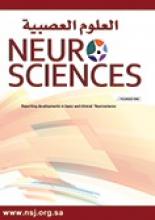Research ArticleOriginal Article
Open Access
Corpus callosum index correlates with brain volumetry and disability in multiple sclerosis patients
Stefanus E. Sugijono, Rahmad Mulyadi, Salsabila Firdausia, Joedo Prihartono and Riwanti Estiasari
Neurosciences Journal July 2020, 25 (3) 193-199; DOI: https://doi.org/10.17712/nsj.2020.3.20190093
Stefanus E. Sugijono
From the Department of Radiology (Sugijono), Division of Neuroradiology (Mulyadi), Department of Radiology, Department of Neurology (Firdausia, Estiasari), Department of Community Medicine (Prihartono), Faculty of Medicine, University of Indonesia, Cipto Mangunkusumo Hospital, Jakarta, Indonesia.
MDRahmad Mulyadi
From the Department of Radiology (Sugijono), Division of Neuroradiology (Mulyadi), Department of Radiology, Department of Neurology (Firdausia, Estiasari), Department of Community Medicine (Prihartono), Faculty of Medicine, University of Indonesia, Cipto Mangunkusumo Hospital, Jakarta, Indonesia.
MDSalsabila Firdausia
From the Department of Radiology (Sugijono), Division of Neuroradiology (Mulyadi), Department of Radiology, Department of Neurology (Firdausia, Estiasari), Department of Community Medicine (Prihartono), Faculty of Medicine, University of Indonesia, Cipto Mangunkusumo Hospital, Jakarta, Indonesia.
MDJoedo Prihartono
From the Department of Radiology (Sugijono), Division of Neuroradiology (Mulyadi), Department of Radiology, Department of Neurology (Firdausia, Estiasari), Department of Community Medicine (Prihartono), Faculty of Medicine, University of Indonesia, Cipto Mangunkusumo Hospital, Jakarta, Indonesia.
MDRiwanti Estiasari
From the Department of Radiology (Sugijono), Division of Neuroradiology (Mulyadi), Department of Radiology, Department of Neurology (Firdausia, Estiasari), Department of Community Medicine (Prihartono), Faculty of Medicine, University of Indonesia, Cipto Mangunkusumo Hospital, Jakarta, Indonesia.
MD
References
- ↵
- Brownlee WJ,
- Hardy TA,
- Fazekas F,
- Miller DH
- ↵
- Dendrou CA,
- Fugger L,
- Friese MA
- ↵
- Howard J,
- Trevick S,
- Younger DS
- ↵
- Garg N,
- Reddel SW,
- Miller DH,
- Chataway J,
- Riminton DS,
- Barnett Y,
- et al.
- ↵
- Cheong WL,
- Mohan D,
- Warren N,
- Reidpath DD
- ↵
- Islas MÁM,
- Ciampi E
- ↵
- Sumowski JF,
- Benedict R,
- Enzinger C,
- Filippi M,
- Geurts JJ,
- Hamalainen P,
- et al.
- ↵
- Leavitt VM,
- Tosto G,
- Riley CS
- ↵
- Estiasari R,
- Fajrina Y,
- Lastri DN,
- Melani S,
- Maharani K,
- Imran D,
- et al.
- ↵
- Ghione E,
- Bergsland N,
- Dwyer MG,
- Hagemeier J,
- Jakimovski D,
- Paunkoski I,
- et al.
- ↵
- Lassmann H
- ↵
- Popescu V,
- Klaver R,
- Voorn P,
- Galis-De Graaf Y,
- Knol DL,
- Twisk JWR,
- et al.
- ↵
- Rojas JI,
- Patrucco L,
- Miguez J,
- Cristiano E
- ↵
- Grothe M,
- Lotze M,
- Langner S,
- Dressel A
- Bergsland N,
- Horakova D,
- Dwyer MG,
- Uher T,
- Vaneckova M,
- Tyblova M,
- et al.
- ↵
- Fisher E,
- Lee JC,
- Nakamura K,
- Rudick RA
- ↵
- Alroughani R,
- Deleu D,
- El Salem K,
- Al-Hashel J,
- Alexander KJ,
- Abdelrazek MA,
- et al.
- ↵
- Paul F
- Llufriu S,
- Blanco Y,
- Martinez-Heras E,
- Casanova-Molla J,
- Gabilondo I,
- Sepulveda M,
- et al.
- ↵
- Granberg T,
- Martola J,
- Bergendal G,
- Shams S,
- Damangir S,
- Aspelin P,
- et al.
- ↵
- Papathanasiou A,
- Messinis L,
- Zampakis P,
- Papathanasopoulos P
- ↵
- Dewey J,
- Hana G,
- Russell T,
- Price J,
- McCaffrey D,
- Harezlak J,
- et al.
- ↵
- Vidal-Jordana A,
- Pareto D,
- Sastre-Garriga J,
- Auger C,
- Ciampi E,
- Montalban X,
- et al.
- ↵
- Figueira FFA,
- dos Santos VS,
- Figueira GMA,
- da Silva ÂCM
- ↵
- Yaldizli Ö,
- Atefy R,
- Gass A,
- Sturm D,
- Glassl S,
- Tettenborn B,
- et al.
- ↵
- Fischl B
- ↵
- Gonçalves LI,
- dos Passos GR,
- Conzatti LP,
- Burger JLP,
- Tomasi GH,
- Zandoná MÉ,
- et al.
- ↵
- Evangelou N
- ↵
- Radü E,
- Bendfeldt K,
- Mueller-Lenke N,
- Magon S,
- Sprenger T
- ↵
- Eshaghi A,
- Prados F,
- Brownlee WJ,
- Altmann DR,
- Tur C,
- Cardoso MJ,
- et al.
- ↵
- Pukenas B
- ↵
- Bergsland N
- Koskimäki F,
- Bernard J,
- Yong J,
- Arndt N,
- Carroll T,
- Lee SK,
- et al.
- ↵
- Jehna M,
- Pirpamer L,
- Khalil M,
- Fuchs S,
- Ropele S,
- Langkammer C,
- et al.
- ↵
- Yaldizli Ö,
- Penner IK,
- Frontzek K,
- Naegelin Y,
- Amann M,
- Papadopoulou A,
- et al.
- ↵
- Caligiuri ME,
- Barone S,
- Cherubini A,
- Augimeri A,
- Chiriaco C,
- Trotta M,
- et al.
- ↵
- Barone S,
- Caligiuri ME,
- Valentino P,
- Cherubini A,
- Chiriaco C,
- Granata A,
- et al.
- ↵
- Vaneckova M,
- Kalincik T,
- Krasensky J,
- Horakova D,
- Havrdova E,
- Hrebikova T,
- et al.
In this issue
Neurosciences Journal
Vol. 25, Issue 3
1 Jul 2020
Corpus callosum index correlates with brain volumetry and disability in multiple sclerosis patients
Stefanus E. Sugijono, Rahmad Mulyadi, Salsabila Firdausia, Joedo Prihartono, Riwanti Estiasari
Neurosciences Journal Jul 2020, 25 (3) 193-199; DOI: 10.17712/nsj.2020.3.20190093
Jump to section
Related Articles
- No related articles found.
Cited By...
- No citing articles found.





